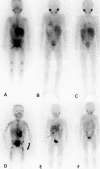Dinutuximab beta plus conventional chemotherapy for relapsed/refractory high-risk neuroblastoma: A single-center experience
- PMID: 36620564
- PMCID: PMC9816792
- DOI: 10.3389/fonc.2022.1041443
Dinutuximab beta plus conventional chemotherapy for relapsed/refractory high-risk neuroblastoma: A single-center experience
Abstract
Background: Relapsed/refractory high-risk neuroblastoma has a dismal prognosis. Anti-GD2-mediated chemo-immunotherapy has a notable anti-tumor activity in patients with relapsed/refractory high-risk neuroblastoma. The purpose of this study was to analyze the efficacy and safety of the combination of immunotherapy with dinutuximab beta (DB) and chemotherapy in patients with relapsed/refractory high-risk neuroblastoma.
Methods: All patients received the Turkish Pediatric Oncology Group NB 2009 national protocol for HR-NB treatment at the time of diagnosis. Salvage treatments were administered after progression or relapse. The patients who could not achieve remission in primary or metastatic sites were included in the study. The most common chemotherapy scheme was irinotecan and temozolomide. DB was administered intravenously for 10 days through continuous infusion with 10 mg/m2 per day. The patients received 2 to 14 successive cycles with duration of 28 days each. Disease assessment was performed after cycles 2, 4, and 6 and every 2 to 3 cycles thereafter.
Results: Between January 2020 and March 2022, nineteen patients received a total of 125 cycles of DB and chemotherapy. Objective responses were achieved in 12/19 (63%) patients, including complete remission in 6/19 and partial response in 6/19. Stable disease was observed in two patients. The remaining five patients developed bone/bone marrow and soft tissue progression after 2-4 cycles of treatment. The most common Grade ≥3 toxicities were leukopenia, thrombocytopenia, hypertransaminasemia, fever, rash/itching and capillary leak syndrome, respectively.
Conclusion: Our study results suggest that DB-based chemo-immunotherapy seems to be suitable with encouraging response rates in patients with relapsed/refractory high-risk neuroblastoma.
Keywords: anti-GD2; dinutuximab beta; neuroblastoma; refractory; relapsed.
Copyright © 2022 Olgun, Cecen, Ince, Kizmazoglu, Baysal, Onal, Ozdogan, Guleryuz, Cetingoz, Demiral, Olguner, Celik, Kamer, Ozer, Altun and Aktas.
Conflict of interest statement
The authors declare that the research was conducted in the absence of any commercial or financial relationships that could be construed as a potential conflict of interest.
Figures

References
-
- Matthay KK, Reynolds CP, Seeger RC, Shimada H, Adkins ES, Haas-Kogan D, et al. . Long-term results for children with high-risk neuroblastoma treated on a randomized trial of myeloablative therapy followed by 13-Cis-Retinoic acid: A children's oncology group study. J Clin Oncol Off J Am Soc Clin Oncol (2009) 27(7):1007–13. doi: 10.1200/JCO.2007.13.8925 - DOI - PMC - PubMed
-
- Ladenstein R, Potschger U, Pearson ADJ, Brock P, Luksch R, Castel V, et al. . Busulfan and melphalan versus carboplatin, etoposide, and melphalan as high-dose chemotherapy for high-risk neuroblastoma (Hr-Nbl1/Siopen): An international, randomised, multi-arm, open-label, phase 3 trial. Lancet Oncol (2017) 18(4):500–14. doi: 10.1016/S1470-2045(17)30070-0 - DOI - PubMed
LinkOut - more resources
Full Text Sources
Miscellaneous

